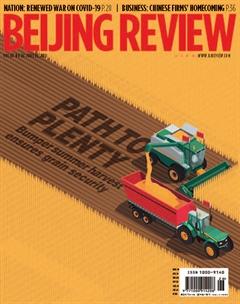A Well-Earned Harvest
Due to the novel coronavirus outbreak, some countries banned grain exports this year while some faced invasion by locust swarms, reducing global grain supplies. This triggered concerns about whether China would face a grain shortage this year. However, the good news is that the summer harvest has been a bumper one and will increase the nations confidence in being able to guarantee its food security.
With almost 90 percent of summer harvest completed by June 15, the Ministry of Agriculture and Rural Affairs (MOA) announced that grain acreage is stable while the yield has improved. This year, summer grain acreage is about 27 million hectares, almost the same as in the previous year, but the per-hectare yield has increased by nearly 60 kilograms.
One reason for this is the MOA directing various local agriculture authorities to guide farmers in summer planting, crop control and reaping, which led to an improved use of agricultural machinery and improved harvesting, ensuring that no grain was wasted.
This momentum will continue. Sowing crops for the next season will be accelerated after the summer grain is harvested. Agricultural technicians countrywide will instruct farmers in fi eld management and pest control for the next season to ensure ample grain for the whole year.
China has always given priority to food security, considering self-suffi ciency in staple food as the bottom line of that. There have been bumper grain productions for years with the per-capita grain possession remaining above the world average since 2010. The per-capita grain possession in China was around 470 kilograms in 2019, higher than the international food security baseline of 400 kilograms. Staple food therefore remains absolutely secured in China.
Besides, there are ample grain reserves to buttress food security. According to MOA figures, the stocks-to-use ratio for grain is much higher than the safety limit of 17-18 percent set by the Food and Agriculture Organization. In particular, wheat and rice stocks, the two major staple foods, are suffi cient to feed the entire nation for one year.
Even when the epidemic was severe in China, grain and non-staple food were in ample supply with their prices remaining stable, and the people never suffered any grain shortage.
But despite the reassuring situation, grain production was not relaxed. After the outbreak, the Central Government adopted measures to coordinate both epidemic control and spring plowing to secure this years production, providing unprecedented support to farmers. This came in the form of funding and ensuring a steady supply of seeds, pesticides, fertilizers and agricultural machinery.
The plentiful summer harvest even against the backdrop of an all-out battle against the novel coronavirus proves that Chinas food security can be self-guaranteed at any time.

